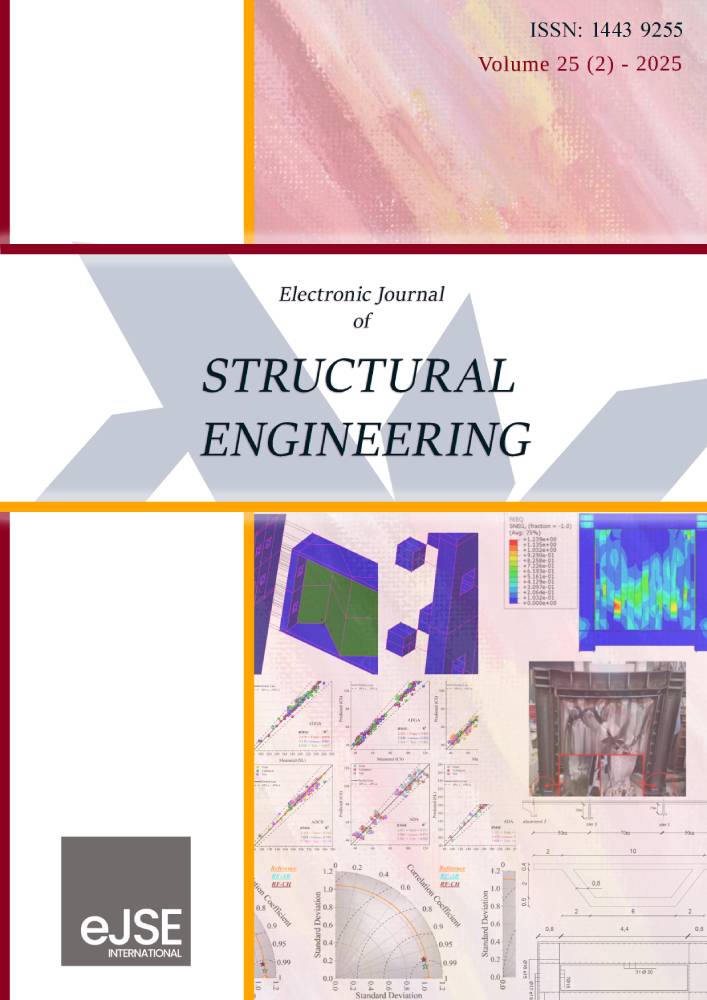Predictive Modeling of Compressive Strength and Slump in High-Performance Concrete Utilizing Machine Learning
DOI:
https://doi.org/10.56748/ejse.24713Keywords:
high-performance concrete, slump, compressive strength, machine learning (ML), metaheuristic frameworksAbstract
Compressive strength is important in HPC, for it actually reflects the ability to bear stresses without disintegration. It ensures structural stability and durability and, hence, resistance to various types of external loads, which is critical for infrastructure serviceability over a long period of time. Whereas slump is indicative of the uniformity and workability of HPC, it affects the ease of placing and consolidation, and construction quality and efficiency. Mix design optimization, through proper balancing between compressive strength and slump, will enhance the capability of HPC to meet the stringent operational standard for heavy applications like bridges, high-rise buildings, and nuclear facilities concerning safety and longevity with cost-effectiveness while constructing the projects. The research estimates the compressive strength and slump of the HPC by advanced machine learning regression frameworks such as ADAR, SVR, and three optimizers: GOA and CBOA. Combining these frameworks with an optimizer results in a novel hybrid framework that not only gives enhanced precision and functionality. Results show that the ADGA model is also optimum in the CS target during training, with an RMSE of 2.451 and a value of 0.992 for R2, followed by the ADCB model outperforming the base model ADA with an RMSE of 3.618 and 0.982 for R2. Notably, the SVR model and its hybrid forms exhibit poorer operation compared to the ADA model in the CS target. These results then emphasize the capability of hybrid ML frameworks in predicting the characteristics of concrete with a good degree of accuracy.
Downloads
References
Abdullahi, M. (2012). Effect of aggregate type on compressive strength of concrete. International Journal of Civil & Structural Engineering, 2(3), 791–800.
Abuodeh, O. R., Abdalla, J. A., & Hawileh, R. A. (2020). Assessment of compressive strength of Ultra-high Performance Concrete using deep machine learning techniques. Applied Soft Computing, 95, 106552.
Aginam, C. H., Chidolue, C. A., & Nwakire, C. (2013). Investigating the effects of coarse aggregate types on the compressive strength of concrete. International Journal of Engineering Research and Applications, 3(4), 1140–1144.
Aginam, C. H., Umenwaliri, S. N., & Nwakire, C. (2013). Influence of mix design methods on the compressive strength of concrete. ARPN Journal of Engineering and Applied Sciences, 8(6), 438–444.
Ahmad, A., Farooq, F., Niewiadomski, P., Ostrowski, K., Akbar, A., Aslam, F., & Alyousef, R. (2021). Prediction of compressive strength of fly ash based concrete using individual and ensemble algorithm. Materials, 14(4), 794.
Ahmad, A., Farooq, F., Ostrowski, K. A., Śliwa-Wieczorek, K., & Czarnecki, S. (2021). Application of novel machine learning techniques for predicting the surface chloride concentration in concrete containing waste material. Materials, 14(9), 2297.
Ahmad, A., Ostrowski, K. A., Maślak, M., Farooq, F., Mehmood, I., & Nafees, A. (2021). Comparative study of supervised machine learning algorithms for predicting the compressive strength of concrete at high temperature. Materials, 14(15), 4222.
Ahmad, W., Ahmad, A., Ostrowski, K. A., Aslam, F., Joyklad, P., & Zajdel, P. (2021). Application of advanced machine learning approaches to predict the compressive strength of concrete containing supplementary cementitious materials. Materials, 14(19), 5762.
Akbarzadeh, M. R., Ghafourian, H., Anvari, A., Pourhanasa, R., & Nehdi, M. L. (2023). Estimating Compressive Strength of Concrete Using Neural Electromagnetic Field Optimization. Materials, 16(11), 4200. doi: doi.org/10.3390/ma16114200
Alexandridis, A., Stavrakas, I., Stergiopoulos, C., Hloupis, G., Ninos, K., & Triantis, D. (2015). Non-destructive assessment of the three-point-bending strength of mortar beams using radial basis function neural networks. Computers and Concrete, 16(6), 919–932.
Algaifi, H. A., Alqarni, A. S., Alyousef, R., Bakar, S. A., Ibrahim, M. H. W., Shahidan, S., Ibrahim, M., & Salami, B. A. (2021). Mathematical prediction of the compressive strength of bacterial concrete using gene expression programming. Ain Shams Engineering Journal, 12(4), 3629–3639.
Ambroziak, A., & Ziolkowski, P. (2020). Concrete compressive strength under changing environmental conditions during placement processes. Materials, 13(20), 4577.
Amin, M. N., Iqtidar, A., Khan, K., Javed, M. F., Shalabi, F. I., & Qadir, M. G. (2021). Comparison of Machine Learning Approaches with Traditional Methods for Predicting the Compressive Strength of Rice Husk Ash Concrete. Crystals, 11(7), 779.
Atiş, C. D., Özcan, F., Kılıc, A., Karahan, O., Bilim, C., & Severcan, M. H. (2005). Influence of dry and wet curing conditions on compressive strength of silica fume concrete. Building and Environment, 40(12), 1678–1683.
Chaabene, W. Ben, Flah, M., & Nehdi, M. L. (2020). Machine learning prediction of mechanical properties of concrete: Critical review. Construction and Building Materials, 260, 119889.
Chang, P.-K. (2004). An approach to optimizing mix design for properties of high-performance concrete. Cement and Concrete Research, 34(4), 623–629.
Chen, L., Kou, C.-H., & Ma, S.-W. (2014). Prediction of slump flow of high-performance concrete via parallel hyper-cubic gene-expression programming. Engineering Applications of Artificial Intelligence, 34, 66–74.
DeRousseau, M. A., Kasprzyk, J. R., & Srubar, W. V. (2018). Computational design optimization of concrete mixtures: A review. Cement and Concrete Research, 109, 42–53.
Dushimimana, A., Niyonsenga, A. A., & Nzamurambaho, F. (2021). A review on strength development of high performance concrete. Construction and Building Materials, 307, 124865.
Farzadnia, N., Ali, A. A. A., & Demirboga, R. (2011). Incorporation of mineral admixtures in sustainable high performance concrete. International Journal of Sustainable Construction Engineering and Technology, 2(1).
Freund, Y., & Schapire, R. E. (1999). Adaptive game playing using multiplicative weights. Games and Economic Behavior, 29(1–2), 79–103.
Hasan, N. M. S., Sobuz, M. H. R., Khan, M. M. H., Mim, N. J., Meraz, M. M., Datta, S. D., Rana, M. J., Saha, A., Akid, A. S. M., & Mehedi, M. T. (2022). Integration of rice husk ash as supplementary cementitious material in the production of sustainable high-strength concrete. Materials, 15(22), 8171.
Islam, M. N., Mohd Zain, M. F., & Jamil, M. (2012). Prediction of strength and slump of rice husk ash incorporated high-performance concrete. Journal of Civil Engineering and Management, 18(3), 310–317.
Khoury, G. A. (1992). Compressive strength of concrete at high temperatures: a reassessment. Magazine of Concrete Research, 44(161), 291–309.
Kim, J.-K., & Yi, S.-T. (2002). Application of size effect to compressive strength of concrete members. Sadhana, 27, 467–484.
Liu, F., & Li, Q. M. (2019). Strain-rate effect on the compressive strength of brittle materials and its implementation into material strength model. International Journal of Impact Engineering, 130, 113–123.
Mahajan, L., Mahadik, S., & Bhagat, S. R. (2020). Investigation of fly ash concrete by slump cone and compaction factor test. IOP Conference Series: Materials Science and Engineering, 970(1), 12011.
Malhotra, H. L. (1956). The effect of temperature on the compressive strength of concrete. Magazine of Concrete Research, 8(23), 85–94.
Moccia, F., Yu, Q., Fernández Ruiz, M., & Muttoni, A. (2021). Concrete compressive strength: From material characterization to a structural value. Structural Concrete, 22, E634–E654.
Mosaberpanah, M. A., & Umar, S. A. (2020). Utilizing rice husk ash as supplement to cementitious materials on performance of ultra high performance concrete:–a review. Materials Today Sustainability, 7, 100030.
Murali, G., Haridharan, M. K., Abid, S. R., Mohan, C., Khera, G. S., & Bandhavi, C. (2023). Compressive strength and impact strength of preplaced aggregate fibre reinforced concrete. Materials Today: Proceedings.
Napoli, A., & Realfonzo, R. (2020). Compressive strength of concrete confined with fabric reinforced cementitious matrix (FRCM): Analytical models. Composites Part C: Open Access, 2, 100032.
Ngugi, H. N., Mutuku, R. N., & Gariy, Z. A. (2014). Effects of sand quality on compressive strength of concrete: A case of Nairobi County and Its Environs, Kenya. Open Journal of Civil Engineering, 2014.
Ni, H.-G., & Wang, J.-Z. (2000). Prediction of compressive strength of concrete by neural networks. Cement and Concrete Research, 30(8), 1245–1250.
Obi Lawrence, E. (2016). Empirical investigation of the effects of water quality on concrete compressive strength. International Journal of Constructive Research in Civil Engineering, 2(5), 30–35.
Parande, A. K. (2013). Role of ingredients for high strength and high performance concrete–a review. Advances in Concrete Construction, 1(2), 151.
Paudel, S., Pudasaini, A., Shrestha, R. K., & Kharel, E. (2023). Compressive strength of concrete material using machine learning techniques. Cleaner Engineering and Technology, 15, 100661.
Pourbaba, M., Asefi, E., Sadaghian, H., & Mirmiran, A. (2018). Effect of age on the compressive strength of ultra-high-performance fiber-reinforced concrete. Construction and Building Materials, 175, 402–410.
Ruggieri, S., Cardellicchio, A., Leggieri, V., & Uva, G. (2021). Machine-learning based vulnerability analysis of existing buildings. Automation in Construction, 132, 103936.
Sadaghat, B., Ebrahimi, S. A., Souri, O., Yahyavi Niar, M., & Akbarzadeh, M. R. (2024). Evaluating strength properties of Eco-friendly Seashell-Containing Concrete: Comparative analysis of hybrid and ensemble boosting methods based on environmental effects of seashell usage. Engineering Applications of Artificial Intelligence, 133, 108388. doi: doi.org/10.1016/j.engappai.2024.108388
Salem, M. A. A., & Pandey, R. K. (2015). Effect of cement-water ratio on compressive strengthand density of concrete. International Journal of Engineering Research and Technology (IJERT), 4(2).
Shah, H. A., Rehman, S. K. U., Javed, M. F., & Iftikhar, Y. (2022). Prediction of compressive and splitting tensile strength of concrete with fly ash by using gene expression programming. Structural Concrete, 23(4), 2435–2449.
Sharma, R. (2021). Effect of wastes and admixtures on compressive strength of concrete. Journal of Engineering, Design and Technology, 19(1), 219–244.
Silveira, L., de Almeida Jácomo, A. T., Furtado, M. M., Torres, N. M., Sollmann, R., & Vynne, C. (2009). Ecology of the giant armadillo (Priodontes maximus) in the grasslands of central Brazil. Edentata, 2009(10), 25–34.
Song, H., Ahmad, A., Farooq, F., Ostrowski, K. A., Maślak, M., Czarnecki, S., & Aslam, F. (2021). Predicting the compressive strength of concrete with fly ash admixture using machine learning algorithms. Construction and Building Materials, 308, 125021.
Song, H., Ahmad, A., Ostrowski, K. A., & Dudek, M. (2021). Analyzing the compressive strength of ceramic waste-based concrete using experiment and artificial neural network (ANN) approach. Materials, 14(16), 4518.
Sun, J., Ma, Y., Li, J., Zhang, J., Ren, Z., & Wang, X. (2021). Machine learning-aided design and prediction of cementitious composites containing graphite and slag powder. Journal of Building Engineering, 43, 102544.
Tan, Z., Bernal, S. A., & Provis, J. L. (2017). Reproducible mini-slump test procedure for measuring the yield stress of cementitious pastes. Materials and Structures, 50, 1–12.
Tasevski, D., Fernández Ruiz, M., & Muttoni, A. (2019). Assessing the compressive strength of concrete under sustained actions: From refined models to simple design expressions. Structural Concrete, 20(3), 971–985.
Tavana Amlashi, A., Mohammadi Golafshani, E., Ebrahimi, S. A., & Behnood, A. (2023). Estimation of the compressive strength of green concretes containing rice husk ash: a comparison of different machine learning approaches. European Journal of Environmental and Civil Engineering, 27(2), 961–983.
Trojovská, E., & Dehghani, M. (2022). A new human-based metahurestic optimization method based on mimicking cooking training. Scientific Reports, 12(1), 14861.
Vapnik, V. (1998). Statistical Learning Theory. New York: John Willey & Sons. Inc.
Vapnik, V. N. (1998). The nature of statistical learning. (No Title).
Vu, C.-C., Plé, O., Weiss, J., & Amitrano, D. (2020). Revisiting the concept of characteristic compressive strength of concrete. Construction and Building Materials, 263, 120126.
Yen, T., Tang, C.-W., Chang, C.-S., & Chen, K.-H. (1999). Flow behaviour of high strength high-performance concrete. Cement and Concrete Composites, 21(5–6), 413–424.
Zhutovsky, S., & Kovler, K. (2017). Influence of water to cement ratio on the efficiency of internal curing of high-performance concrete. Construction and Building Materials, 144, 311–316.
Downloads
Published
How to Cite
Issue
Section
License
Copyright (c) 2025 Yu Yang, Ye Chen, Peng Zhang, Weining Zhang

This work is licensed under a Creative Commons Attribution 4.0 International License.







